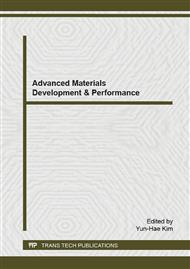p.197
p.203
p.207
p.211
p.218
p.222
p.226
p.231
p.235
Morphological, Electrical and Optical Properties of Al-Doped Zinc Oxide Nanorods
Abstract:
We have studied the structural, electrical and optical properties of Al-doped Zinc Oxide (ZnO) nanostructures deposited on glass substrate by chemical bath deposition method. Scanning electrom microscope images clearly reveal that AZO nanorods were successfully grown. The XRD analysis indicates that polycrystalline nature of ZnO nanorods. The calculated grain size is about 84 nm. Electrical resistivity measurement study showes the minimum d.c. resistivity of 3.216×10-4 Ω.cm was obtained for the AZO films sintered at 300°C. It gives AZO can be adopted as a transparant conductive oxide (TCO) material. Optical transmission spectra showes that more than 80% transmission and 3.47 eV optical band gap of harvested AZO films. It is a potential candidate for ligth emitting diodes (LEDs), photonic crystals, TCO and photovoltaic application.
Info:
Periodical:
Pages:
218-221
Citation:
Online since:
June 2015
Authors:
Keywords:
Price:
Сopyright:
© 2015 Trans Tech Publications Ltd. All Rights Reserved
Share:
Citation:


